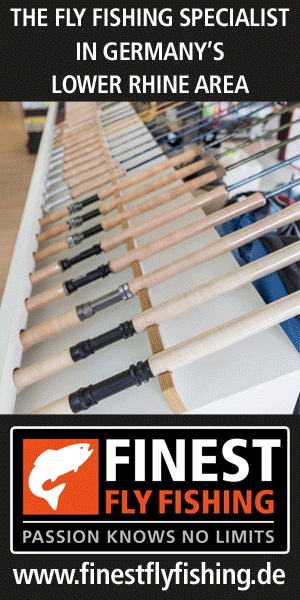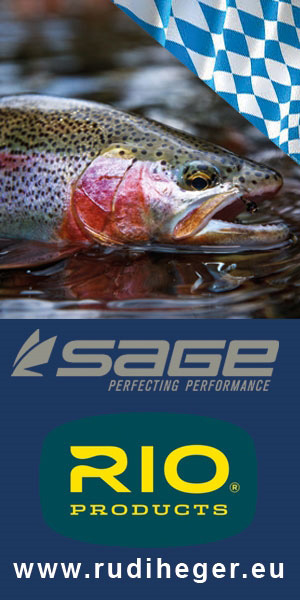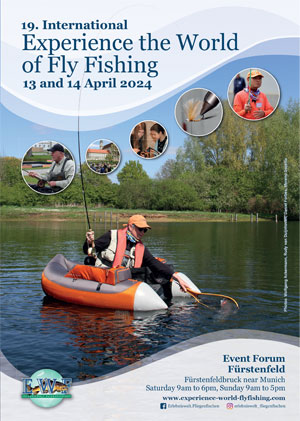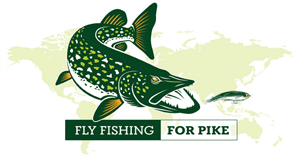
The flies that we use to fish for pike are usually big; they have heavy hooks in them and account for a fair amount of air-resistance. How do we go about casting these streamers?
Using the right combination of tackle is a big help in casting pike-streamers. A #5 or 6 weight rod and line combination is only capable of casting relatively small streamers; flies that are perhaps ten to twelve centimetres in length and that are not too bulky. This is perfect when, for instance, fishing in the polders in the summertime, when the pike are after small baitfish anyway. In order to cast really big streamers we need to get our hands on a much heavier rod and line combination, from an #8 weight even up to a #10 weight if necessary.

Most rods for these line-classes are nine foot in length and that is perfectly well, although some flyfishers prefer the extra length of a ten foot rod, when fishing from a belly boat, for example. The rod does not need to be ultra light, I much prefer blanks that have thick walls and therefore can handle some of the beating that we expose it to. A stiff action is needed to drive a big hook home, a slightly slower action makes casting big streamers somewhat easier, so this is where we will have to find a compromise for ourselves.
Large guides on the rod will make shooting the line that much easier, a fighting butt is comfortable when fighting big pike, it takes some of the strain of the wrist of the hand with which you are holding your rod. The reel holder on the rod should be of the up locking type and have two screws instead of just one; the reel well seldom come loose in a reel holder of that type.
Fly-lines
As for floating lines I would choose any of the bass bug, saltwater (both for cold water conditions!) or special streamer fly lines that are on the market now. Compared with normal weight forward (WF) fly lines, these lines have a much shorter head. A Rio InTouch Pike/Musky Fly Line for instance has a head that is 29 foot in length, as compared to a length of 43 to 47 foot for the Rio LightLine and Gold fly lines. Because the weight of the head of the line is compressed in a much shorter section, these lines make casting a big streamer a whole lot easier. They will pull the streamer behind them much better than a standard weight forward line ever could and deliver it further with much less effort.

Instead of a floating line, many pike anglers prefer to use intermediate glass lines. These lines are less visible to the fish, they will cast less of a shadow under water and because waves do not have an effect on them, you will have a much better contact with your streamer on a windy day. Also when by the end of autumn the weeds in the water start to disappear, than it often pays off to fish just that little bit deeper.
When you need to go deeper, when fishing lakes from a boat or belly boat or so, or when you want to fish a floating streamer on a sinking line, than fast sinking shooting head lines come into play. Teeny Nymph Lines were, as far as I know, originally developed to fish deep and fast running water for steelhead. They are actually fast sinking shooting head lines to which the floating or intermediate running line is permanently attached. The sinking head of a Teeny Nymph Line T-300 has a weight of 300 grains, which is something like 24 grams; the T-400 weights 400 grains, etc. When on a steelhead river one could not reach the bottom with a T-200, than the line was reeled in back on the spool and the spool or reel was changed for one with a T-300 line on it. As you may have noticed there is no AFTMA number for these lines, but on average a T-200 can be cast on rods #6 and 7, a T-300 on rods #8 and 9, for the T-400 you will need a rod build for a #9 through 11 weight fly line. Other manufacturers have similar lines in their range, Rio has the InTouch Sink Tip 24 Ft Density Compensated, Airflo the DepthFinder. Scientific Anglers calls a somewhat similar line the Sonar Titan. A T-300 will take your streamer to the desired depth quickly. When fly fishing for seabass I even touch the bottom at eight or nine metres down in a good tidal flow when I cast my seabass streamer far enough upstream. A T-200 or equivalent is too light to bring a big streamer down, still I use it a lot to fly-fish for zander.
Leaders
The longer we make our leader, the more difficult it will become to cast a big streamer. On a long leader a streamer will go its own way when we try to cast it, making it very hard on ourselves. For sinking lines I seldom if ever use leaders that are more than 1,50 metres in length. For a floating line I sometimes go over that mark, but never do I use leaders that are more than 2,00 metres in length, and that includes the piece of steel wire in front of my streamer. I like to keep the leaders I use for streamer fishing pretty simple. Two lengths of nylon, 75 centimetre of 40 to 50/00 and 75 centimetre of 35 to 40/00, has served me well so far. The leader is connected to the fly-line by a nail knot; when I make use of braided loops, I will secure these with watertight superglue and/or some speed nail knots that can be made with some short pieces of nylon. When the braided loop is not secured, than – when fighting a nice pike – the top ring on your fly rod will have the same effect as your nails when you replace the braided loop: the loop will slide of the fly line and the pike regains it’s freedom before you were able to unhook it…

Some people prefer to use a length of kevlar right in front of the streamer, but I have had pike take the streamer and part of the kevlar line of the leader without me feeling any take at all! At another occasions a friend of mine fought a nice pike towards him, the head of pike came out of the water and when it started to shake it, all those hundreds of teeth came in contact with the kevlar line. Again it did not take long before the pike regained her freedom and she had not even been landed yet.
Fly casting
The heavy rods and large reels that we use for streamer fishing make it necessary for us to place the thumb on top when we are casting. Using the forefinger on top of the handle, the way I prefer it for rod and line combinations up to a line class #6, would be too tiring for the finger because of the weight of the combination. Placing the thumb on top means that you will have to pay more attention to not going too far down on the back cast and not to use too much power.
Fly casting, even casting big ‘half chickens’, has nothing to do with power, it is all about technique. The more force you put into your casting, the worse it is likely to get. By the end of the cast all energy should have gone out of the line and it falls straight on the water. When the line falls on the water in a number of big bends, than that is an indication that you have been using to much power in your casting. By the end of the cast there is still a lot of energy left in the line, and streamer, leader and fly line come back like a spring.
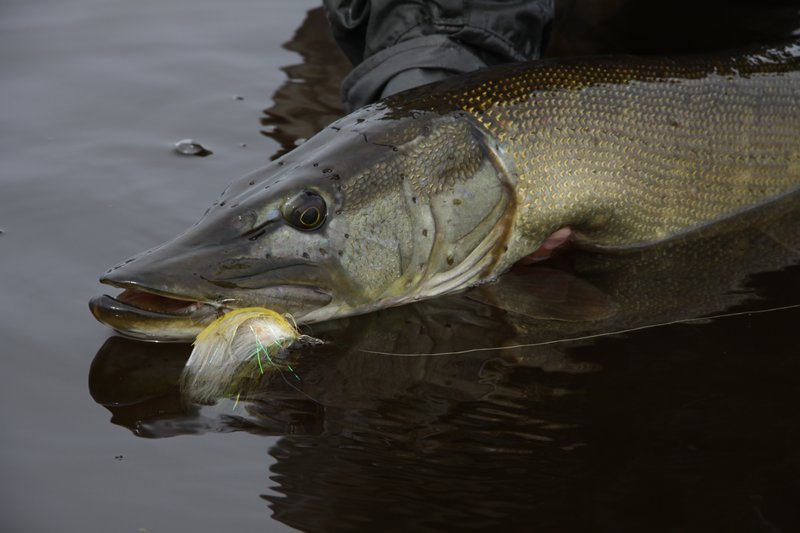
It is impossible to pick up a long line plus your streamer, both would probably hit the bottom or water behind you when you do, so strip in enough line until there is about eight or ten metres left outside the rod tip. Start picking up the line with your rod tip close to the surface of the water. This way you can lift all of the line of the water and accelerate the line into the air behind you when only the leader is still on the surface. Pick up the line slowly, a spray of water will, in shallow water, scare any fish that lie beneath it.
The back cast is made by slowly increasing speed and by making a sudden stop with your rod in about the 1 o’clock position. With the thumb on top of the rod, it is easy to go well beyond that position, maybe as low as 2 or 3 o’clock. But this will cause the line and leader to travel much closer to the bottom and possibly bushes behind you. The risk of getting stuck there are high and even if this is not the case, you will lose control over your cast anyway when the line and streamer hit the bottom behind you. So make that stop at the 1 o’clock and, as you will see when you follow the line with your eyes behind you, the fly line and streamer will stay well above the meadow behind you.
Straighten out
You will never get a good forward cast, if the back cast was a bad one. With an air-resistant fly like a pike streamer you will have to wait just a little bit longer – until the streamer has reached its furthest away point behind you – before you can start the forward cast. When the streamer was still on the way back, you will just waist energy on your forward cast trying to straighten the line first. When casting small flies you will, when starting your forward cast too soon, hear a sharp snap (like the sound of a whip) and the fly is gone. A few more of the bad casts and the nylon tippet flares open… It is no problem to drift back a bit with the tip of your rod after you made that sudden stop at 1 o’clock, but that is a different thing than making a stop at 2 o’clock.

The forward cast should be a copy of the back cast, slowly increase speed toward the 11 o’clock position and make a sudden stop there. If you make that stop to low before you, the streamer and fly line will hit the water in stead of landing on it and they will not reach the desired distance. If, on the other hand, you make that stop around the 12 o’clock position, the fly will go high into the air, reach its maximum distance but then comes sailing back towards you.
Another problem that arises here, one that might occur on the forward as well as the back cast, is the tailing loop. The streamer and leader move upward on their path away from you and will tangle in the fly line. This tailing loop could be the result of a number of casting faults. The first one is, on the forward cast for example, to make that sudden stop before the 12 o’clock position after which the rod is pushed down to the 11 o’clock point. With that forward cast we increase speed with the rod all the way from a position behind us to the 11 o’clock position. In this way the streamer will travel over the tip of the rod and above the fly line and will not get entangled in it.
Too soon
Another fault that causes tailing loops is hauling to soon. When single or double hauling, make sure that your haul coincides with the sudden stop with your rod hand. A great many casters place their haul too soon, which causes one tailing loop after the other or just one on that one final cast.
When casting between the 1 and 11 o’clock positions, we achieve a narrow angle if we draw a line between the rod positions on the forward and back cast. With that narrow angle we achieve a narrow loop in our casting, one that will cut through the wind more easily and with which we can reach larger distances. If we widen that angle, which means we stop our rod at, for instance, 2 and 10 o’clock, we will also get much wider loops. When casting really big streamers it can be advisable to open up that loop, but do not overdo it.

In order to load the rod even more, you can shift the rod forward and backward during the cast (without opening the angle!). This may be necessary to reach even further away lies, but usually it is easier to wade a little further or get closer to the spot with your boat or belly boat. You should be able to reach most spots that are within casting range with two or three false casts, whereby you shoot line on both the forward and back cast.
Try not to keep too much line in the air, streamer fly lines, with their short bellies, are not really made for this. The thin running line can not transport enough energy to keep in full control of the heavy front part, leader and streamer. So when you have one or one and a half metres of the thin running line outside the tip ring of your rod, than make a proper forward cast with enough speed build into it and shoot the rest of the line. The same applies to shooting head lines, you will also loose control over these heads when you let more than one and a half metres of the thin running line slip out of your finger before making the final forward cast.
In control of the wind
As a right handed fly caster it is most convenient for you if the wind comes from the left when you are casting. For left handed casters it is of course the other way around. If there is a wind from the right in the area that one fishes, than many right handed casters will start lowering the rod toward the right in an effort to prevent the streamer from hitting the rod. No matter how far you go down with your rod, this can still occur at regular intervals and it is for sure not something to look forward too. A streamer travelling at full speed will easily damage the layer of lacquer on your rod and perhaps even the rod itself. It may not break right away at the spot where the hook or wire trace hits the blank, but it might well do so in the future.

As a right handed caster, it is my preference to cast across my left shoulder when I have a wind blowing from the right. For this it may well be enough to cast in a perfectly vertical plane, otherwise I will tip my rod, while casting over to my left shoulder. So I keep casting with my hand in a normal position to the right of me, but the rod tip is tilted to the left instead of somewhat to the right. This way the wind will push the fly line, leader and streamer away from my rod, with no chance of damaging it.
Casting into the wind is only possible when you perform a narrow enough loop and execute a good double haul. The wind has too much of a surface to push against when you make large loops, causing for the fly to fall well short of its target and often it ends up going in a wrong direction too. A wind from behind sounds easier, but if we do not get our line and leader straightened out to the back, than we can not perform a proper forward cast.

Once the line flies like it should fly, with a streamer chasing the tip of the line at high speed, when we get our streamer there were we want it to be and when a bow wave starts to follow our streamer after the first initial strips, than we know that there is nothing like fishing for big northern pike with a fly rod.
